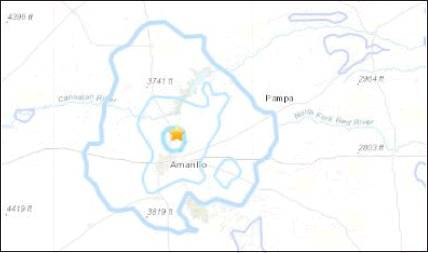Earthquake confirmed northeast of Amarillo
Douglas Clark Amarillo Globe-News dclark@amarillo.com
In the wake of the 4.0 magnitude earthquake recorded north of Amarillo Saturday morning, a Cal Poly Pomona Professor of Geophysics said the activity appears to have occurred in an area that contains fault systems associated with the Amarillo-Wichita uplift.
Jascha Polet, who is also a seismologist, said the uplift is a geological description of this area, which has experienced vertical upward motion during geologic times, resulting in deeper rocks being pushed to the surface and mountain building.
“A recent paper by (Oklahoma Geophysicist / State Seismologist) Jacob Walter analyzed earthquake data in that general region and suggested naturally occurring earthquakes in the Texas and Oklahoma Panhandles, as well as a few examples of earthquakes possibly induced by production, by wastewater injection, or by hydraulic fracturing,” Polet said. “Without a more detailed analysis, it is difficult to state at this point in time whether this earthquake was tectonic in nature or associated with activities of the oil / gas industry.”
The U.S. Geological Survey reported the earthquake recorded north of Amarillo just after 8 a.m. on Saturday, noting via its website the tremor had moderate shaking and light potential damage. Hundreds of residents reported feeling the impact of the earthquake, according to the agency.
“There have been reports of significant earthquakes in the Texas Panhandle, even with some damage in Amarillo, dating back to the early 20th century,” Polet said. “Some of these events are likely to have been larger than magnitude 5."
Walter's paper, Natural and Induced Seismicity in the Texas and Oklahoma Panhandles, was published in Seismological Research Letters and written with co-authors Cliff Frohlich and Taylor Borgfeldt. The article noted the work involved evaluating the probable causes of seismicity in the Texas and Oklahoma Panhandle region, including reviewing historical earthquakes with magnitudes of 3.9 to 5.4 reported between 1917 and 1980 and more recent earthquakes recorded by stations in the EarthScope Transportable Array (TA) between 2008 and 2011.
"We looked at and identified instances where, based on a scoring system, whether an earthquake would be induced by oil and gas activity" he said. "This allows for prediction of earthquakes with more improved methods from data collected eight years ago. Via seismometers we found earthquakes across a belt along the Panhandle and identified an area where activity was probably induced by wastewater injection. We would need updated data to determine that."
Walter said the Texas Panhandle possibly has the second most seismic activity in the state while possessing a history of larger earthquakes dating back to the early 1900s. He said scientists at that time related the activity to oil and gas extraction.
Meanwhile, Polet said the U.S. Geological Survey and other agencies locate earthquakes of the magnitude of the one that occurred in Amarillo nationwide within minutes of their occurrence. She said the earthquake the occurred here is fairly uncommon in terms of its location and magnitude. Additionally, Polet noted the possibility exists for other tremors.
“All earthquakes have aftershocks,” she said. “Usually the earthquakes that follow an earthquake will be smaller in magnitude than the initial event, so other, probably smaller, earthquakes will follow in the next days to weeks. Aftershock activity commonly decays quickly with time, so most aftershocks will occur right after the initial earthquake.”
